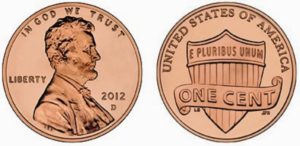Enrich your child’s education – The Penny
June 18, 2017 | By tickettolearn

Where did the name come from, what is it made of and why the design?
We all use money but we almost never stop to consider the story behind the coin or bill we handle daily. With the first introduction of coins around 600 BC, nations began stamping their coins with designs. The Greeks featured their ruler or images of their Gods. By the time of the Roman empire, 99% of the emperors had their images on Roman coins.
What Americans refer to as a penny or $0.01, or one cent comes from the English coin called the Penny. From around 750 AD for 500 years the penny was the only denomination of coin minted and put in circulation in England. The English penny was originally made of silver but like all coins over time the purity would be diluted to save cost. The American version introduced in 1787 was the first money authorized by the Unites States and its original design was suggested by Benjamin Franklin. Originally made from 100% copper, today a penny is 97.5% zinc and 2.5% copper.
Since its introduction, the design has been changed 16 times. President Theodore Roosevelt ordered the likeness of Abraham Lincoln on the coin in 1909 to commemorate Lincoln’s 100th birthday. It was the first time a historical figure was portrayed on a U.S. coin. “In God We Trust” was added at the same time. The “tails” side of the penny has had multiple designs including two wheatheads and the Lincoln Memorial but in 2010 it was changed to the Union Shield with the Latin words “E Pluribus Unum” meaning “From many, One.” Take a look at penny’s you can find to see how many variations you can find and the dates they were minted. Research what the other letters you can see on the penny stand for.
The economics of minting and distributing pennies may no longer make sense. Today it costs roughly $0.0167 (price varies year to year based on raw material costs) to produce and distribute a $0.01 coin with a 30 year life. The Treasury loses over $50 million a year on pennies but to take them out of circulation would make every price round up or down to $0.05.
The penny is a financial instrument which makes a political statement. President Teddy Roosevelt loved Lincoln and wanted to be associated with him. By putting his likeness on the penny Roosevelt was making history and making sure everyone would remember Lincoln. Today, it does not make financial sense to produce and distribute pennies, but the politicians hotly debate the pros and cons of maintaining it.






